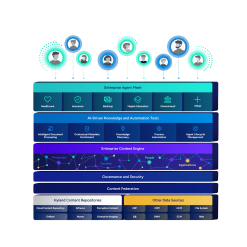What are the benefits of a paperless workplace?
By moving away from paper-based processes, organizations can reduce the risk of errors and oversights that come with manual document management and data entry.

Harness the power of a unified content, process and application intelligence platform to unlock the value of enterprise content.
Learn more
Automate your document-centric processes with AI-powered document capture, separation, classification, extraction and enrichment.
Learn about Hyland IDPIt's your unique digital evolution … but you don't have to face it alone. We understand the landscape of your industry and the unique needs of the people you serve.
 Overview of industries
Overview of industries
Countless teams and departments have transformed the way they work in accounting, HR, legal and more with Hyland solutions.
 Overview of departments
Overview of departments
We are committed to helping you maximize your technology investment so you can best serve your customers.
 Overview of services
Overview of services

Discover why Hyland is trusted by thousands of organizations worldwide.
Hear from our customers
Our exclusive partner programs combine our strengths with yours to create better experiences through content services.
Overview of partners
Join The Shift newsletter for the latest strategies and expert tips from industry leaders. Discover actionable steps to stay innovative.
Register now
Hyland connects your content and systems so you can forge stronger connections with the people who matter most.
Learn about HylandWith our modern, open and cloud-native platforms, you can build strong connections and keep evolving.
 Dig deeper
Dig deeper
Reading time minutes
By moving away from paper-based processes, organizations can reduce the risk of errors and oversights that come with manual document management and data entry.

A paperless office is a workplace that has minimal paper-based processes and relies on digitized documents instead. Some organizations prefer the term “paper-light” as many offices and departments cannot completely eliminate paper files because of process or compliance requirements.
Regardless, reducing the use of paper helps accelerate an organization’s digital transformation journey. This typically involves transitioning to an electronic paperless document managing system that digitizes files and stores it in a central repository.
Corporations in the US spend more than $120 billion per year on printed forms alone, most of which become obsolete within three months and end up in the trash. On top of that, office workers spend 30-40% of their time looking for documents in physical file cabinets.
Some of the most paper-intense departments are human resources, accounts payable and receivable, facilities management and customer service, which deal with a high volume of applications, resumes, receipts, work orders, invoices, bills, and more.
Evidently, working with paper documents creates problems that prevent an employee from being productive and an organization from saving costs. Adopting a paperless system can solve these challenges and achieve benefits like:
Saving time spent on locating and retrieving physical files.
Digital documents can be easily organized and indexed, which makes finding the files you need much faster with search capabilities. As documents become more accessible, the time taken to retrieve files is significantly cut down so your team can be more productive and focus on other high-value tasks.
Promoting collaboration among team members.
Staff are able to share files digitally without printing and view updated and past versions of documents. This minimizes the steps and optimizes the workflow when working together on documents.
Improving security of information.
Access rights can be assigned and revoked according to user level and document type. With granular security settings, confidential and sensitive information can be tracked and protected against misuse and unauthorized changes. This also reduces the risk of loss and theft.
Saving costs spent on printing and storing documents.
Eliminating the majority of paperwork helps you save money spent on paper and filing cabinets, as well as other costs like photocopier ink and office stationery.
A paperless document management system captures and stores information digitally on a single platform with integrated search options. In order to ease the change from paper to digital, you can start by:
As with any change, it will take time for your organization to adjust. It is recommended to start on a smaller scale with critical processes that have the most impact from going paperless, before scaling the solution to other processes and departments.
Related articles